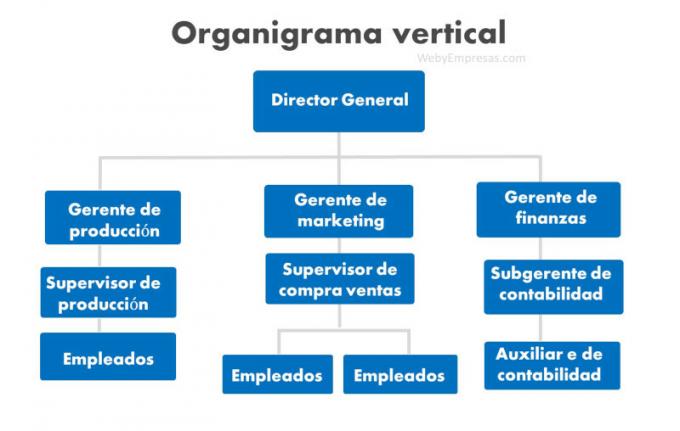A vertical organization chart is a graphical representation of the hierarchical structure of an organization that shows the chain of command in a descending, providing a clear and concise vision of the internal configuration of the company, being essential to define roles and responsibilities.
For every company it is important to outline its hierarchical structure, and one of the most used models is the upright organizational chart, given that allows to visually represent how the chain of command is distributed, using a descending hierarchical order.

Advertisements
Well, the vertical diagram is very useful to understand in a simple way how to delegate functions, from the upper hierarchical levels to the lower levels or positions, whichfacilitates the assignment of responsibilities effectively, and in turn helps decision making.
Let's see what this organizational structure is about.
Advertisements
In this article you will find:
What is a vertical organization chart?
A upright organizational chart is a graphical representation of the hierarchical structureof an organization, which shows the chain of command within it, wherethe upper levels management and leadership are at the top diagram and the lower levels, such as individual employees, they are at the bottom.
The top usually starts with the highest-level leadership position, such as the CEO or president of the company; from there, the diagram extends downward, outlining top-level executives, mid-level managers, and then base-level employees.
Advertisements
For Mario Brume (2019) "Vertical organization charts: Are those in which the highest hierarchy (the hierarchy is the rank that a worker has within a company), organization or institution is placed in the upper part and the branching of the organs is presented from top to bottom, locating the units in rows, whose different level represents their range." (p.49)

Advertisements
Vertical Organization Chart Features
A vertical organizational chart has several key features, including:
- Hierarchy: The main characteristic of a vertical organization chart is that it shows the hierarchy of the organization; the most authoritative positions are at the top of the organizational chart and the levels ofauthority descend downward.
- Reporting Relations: Clearly shows who reports to whom and the lines between the different levels of the organization chart represent the reporting relationships.
- Departmental Structure: A vertical organizational chart can also show the departmental structure of an organization; that is, different departments or teams can be represented as separate branches of the diagram.
- Roles and responsibilities: Often, alongside the names and titles on the organization chart, there may be a description of the roles and responsibilities of each position.
- one way: Normally, vertical organization charts are unidirectional, which means that show who reports to whom, but not necessarily who collaborates with whom. They tend not to be very good at showing more nuanced working relationships, like temporary project teams or collaborative relationships between departments.
- Formality: Vertical organization charts often represent the formal structure of the organization, not necessarily the informal relationships or communication pathways that actually exist in practice.
- simplicity: Although they may be limited in terms of showing all the complexities of an organization, vertical organizational charts they are easy to understand, and provide a clear and simple view of the hierarchical structure of an organization.
Remember that while the vertical organization chart can provide a useful overview of the organization, cannot reflect all the complexities and details of the actual functioning of the organization. organization.
Advertisements
Advantages and Disadvantages of the Vertical Organization Chart
Vertical organizational charts have several advantages and disadvantages associated with them:
Advantages:
- Clarity: A vertical organizational chart provides a clear and concise representation of the hierarchical structure of an organization.
- definition of roles: They help define roles and responsibilities within the organization, which can be useful for personnel management and planning.
- Facilitates decision making: By visualizing the chain of command, it facilitates the decision-making process, since it is known who has the authority to make which decisions.
- Induction and training: They are useful for the induction and training of new employees, as they provide a quick view of the structure of the organization.
Disadvantages:
- Rigidity: A vertical organization chart can give the impression that the structure of the organization is rigid, which it is not. necessarily true, this is because they may not adequately reflect more fluid working relationships or with structures matrix.
- Does not show informal relationships: They do not show the informal working relationships that are often vital to the functioning of an organization.
- Maintenance: As an organization grows and changes, the organization chart can become difficult to maintain and will require regular updates.
- Does not show job details: Although the vertical organization chart shows who reports to whom, they do not provide details on the type of work that each individual or department performs, or how different parts of the organization coordinate to work together.
Usefulness of the vertical organization chart in organizations
The vertical organization chart is a essential tool in management and organizational design, works like a map that represents the hierarchical structure and reporting relationships in an organization, providing a clear and concise vision of the internal configuration of a company or institution.
One of the main uses of vertical organization charts is that they facilitate the understanding of the structure of the organization, at a glance you can visualize the hierarchy, from the CEO or president at the top, to the base level employees at the bottom, this is especially useful for larger and more complex organizations, where the structure can be difficult to understand without a visual representation.
In addition, vertical organization charts are crucial for defining roles and responsibilities, each symbol (rectangles or ovals) represents an individual or a team on an organization chart, and the lines between them represent reporting relationships; this helps to avoid confusion about who reports to whom, and who is responsible for what, thereby facilitating coordination and collaboration within the organization.
It is also an essential tool for planning and managing change.When an organization needs to restructure, expand, or downsize, the organizational chart can help leaders visualize the impact of these changes and plan accordingly effective.
Bibliographic reference
Mario Javier Brume González. ORGANIZATIONAL STRUCTURE. Editorial Seal: Itsa University Institution (978-958-52221). Barranquilla, 2019. ISBN 978-958-52221-1-3.


